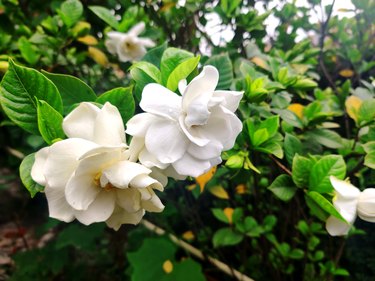
The first place many teenagers encounter the gardenia (Gardenia jasminoides) is in long-lasting, sweet-smelling corsages. The shrubs and their houseplant cousins present challenges to those who would keep them and enjoy their delicate fragrance from late March through mid-June, depending on cultivar. They suffer from several water-related problems that may result in the gardenia wilting. Gardenias, with their creamy blossoms and shiny green leaves, thrive in U.S. Department of Agriculture plant hardiness zones 8 through 10.
Optimal Growing Conditions
Video of the Day
In their native ranges of China and south and east Africa, gardenias have adapted to warm, humid climates, acidic soil and light shade to full sun exposure. Give them an acidic soil with a pH of 5.0 to 6.5, amended with compost to aid drainage. Fertilize camellias from March to August with fish emulsion or fertilizer with a nitrogen-phosphorous-potassium composition of 3-1-2 or 10-5-15 for acid-loving plants.
Video of the Day
Commercial granular fertilizers or a water-soluble fertilizer call for mixing a tablespoon with a gallon of water -- half strength for houseplants -- and fertilizing before and immediately following bloom. Lack of humidity or use of unsterilized garden soil can cause wilting in young and/or potted plants.
Watering Gardenias Properly
Waterlogged soil encourages root rot and root nematode growth, two causes of wilting. In both cases, badly infected plants must be discarded. In cases where only a few roots are infected, pruning affected roots and up to one-third of the gardenia droopy leaves and top growth along with a move to an area -- or re-potting -- with healthy or sterile soil might save the plant.
In the case of root nematodes, no fungicide kills nematodes. Water gardenias to keep moisture even (neither dry or wet) to prevent moisture-loving gardenia pests and root rot. Another option to moving a gardenia in the landscape is to plant it in a raised bed.
Whenever pruning affected plants, sterilize tools between each cut to avoid spreading disease to other roots and parts of the plant. Wipe surfaces of hand pruners or loppers, the long-handled pruners used on thick branches, with a 70 percent solution of rubbing alcohol and water.
Wilting Gardenia and Stem Canker
Wilting leaves on one or more branches may be the result of stem cankers, a fungal disease caused by Phomopsis gardeniae. Again, the progression of the oval or elongated lesions can destroy a plant and it must be destroyed. When only one or a few branches are affected by gardenia pests, they can be pruned out. Try to do any pruning before Oct. 1, when plants begin setting flowers for the next spring.
Caring for Your Gardenias
Well-drained, evenly moist soil is a must for gardenias. Provide room for air circulation by planting them 5 to 6 feet apart outdoors, more for larger shrubs. Give houseplants a 2- to 5-gallon tub with drainage holes. Mulch soil with 1 inch of well-rotted compost for indoor plants and 2 to 3 inches for outdoor shrubs.
Recently grafted or transplanted gardenias require high humidity. Setting plants on trays filled with pebbles and water and frequent misting provides needed moisture.